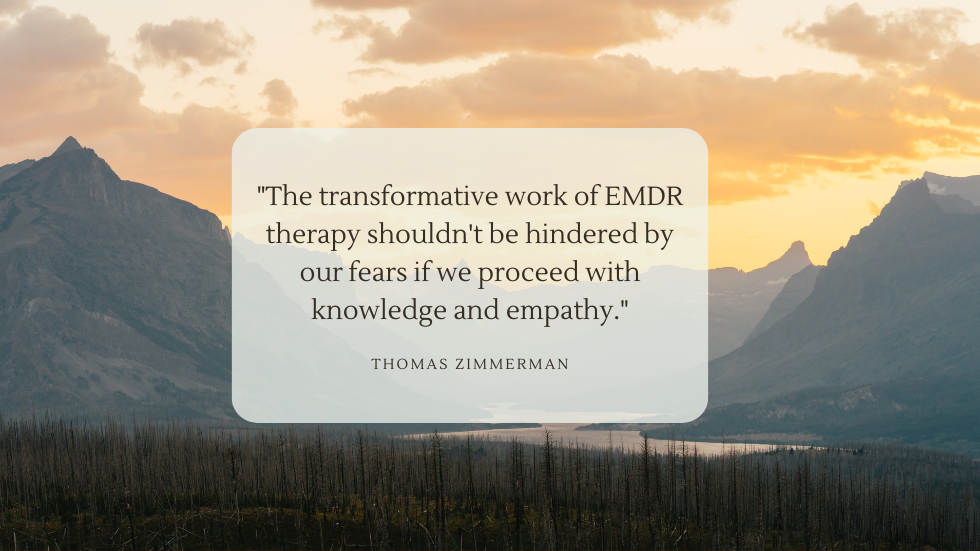Balancing Resourcing and Trauma Reprocessing in EMDR Therapy
Navigating Phase 2 of EMDR therapy involves a delicate balance. Our aim is to equip clients with the resilience they need without veering into over-preparation, which can inadvertently delay a client’s healing process. This balance is nuanced; on one hand, we as therapists are committed to doing no harm, and we are acutely aware of the vulnerability of many of our complex clients. On the other, it is important for us to recognise that avoiding or delaying trauma reprocessing can at times be a disservice to our clients.
It's natural for us to feel apprehensive when addressing traumatic memories with emotionally vulnerable clients. Although trauma reprocessing inherently involves some unpredictability, it's crucial not to let our anxiety hinder the use of evidence-based and robust treatment models like EMDR Therapy, which holds the potential to offer much-needed relief to clients.
Thomas Zimmerman offers us a powerful reminder:
"You, as an EMDR therapist, have been trained in one of the evidence-based therapies that can help them heal. So, I don't want to emphasize the risk of doing this work, as in the risk or the fear of harming, without also emphasizing the risk of not doing the work."
This statement highlights the importance of action — the transformative work of EMDR therapy shouldn't be hindered by our fears if we proceed with knowledge and empathy.
A helpful principle is to not assume that all clients require extensive resourcing work in Phase 2, nor to dive into Phase 3 and beyond in EMDR therapy without firstly assessing that the client is ready to safely do so. Clients vary widely in the extent to which they need different kinds of preparation for EMDR reprocessing. Each client’s circumstances should be considered individually, rather than trying to fit the client into a rigid therapy structure.
Understanding Client Needs
To effectively navigate Phase 2, it is crucial to engage in thorough assessment and ongoing dialogue with our clients. This means evaluating their readiness for reprocessing and their capacity to handle potential emotional disturbances that may arise. This assessment includes understanding their history, current coping mechanisms, and support systems. Clients with robust support networks and effective coping strategies may require less resourcing than those who are more isolated or have fewer coping mechanisms in place.
Moreover, the therapist's intuition and clinical judgement play a significant role. By tuning into the client’s verbal and non-verbal cues, therapists can better gauge their readiness for the next phase of EMDR therapy. Building a strong therapeutic alliance based on trust and communication is fundamental to this process.
The Balance of Resourcing
Over-resourcing can lead to prolonged therapy, which may cause frustration for clients eager to address their traumatic memories. Under-resourcing, on the other hand, can result in clients feeling overwhelmed and potentially re-traumatised. Striking a balance requires a tailored approach that considers each client’s unique needs and circumstances.
Techniques such as grounding exercises, calm place visualisations, and developing coping strategies are essential components of Phase 2. These techniques provide clients with tools to manage distress and create a sense of safety, which is crucial for effective trauma processing. However, these techniques should be used judiciously, ensuring they serve the client’s progress rather than becoming an end in themselves.
Closing Reflections
The journey through Phase 2 of EMDR therapy is not a one-size-fits-all process. It demands a nuanced approach that balances the need for preparation with the imperative to move forward into trauma reprocessing. By carefully assessing each client’s needs and readiness, and by employing a flexible, empathetic approach, we can help our clients navigate their healing journeys more effectively.
As EMDR therapists, our role is to facilitate healing, ensuring that our clients receive the full benefits of this powerful therapy. By embracing the complexity of resourcing and reprocessing, and by remaining attuned to our clients’ individual needs, we can provide the support and guidance necessary for their recovery.
I'm Caroline Burrows, an Accredited EMDR Trainer and Consultant. I’m passionate about bridging the gap between EMDR training and clinical practice. If you're looking to learn EMDR therapy for the first time, enhance your EMDR skills, or navigate challenges in your EMDR clinical work, I offer training workshops, on-demand webinars, and consultation. I would love to support your EMDR learning journey.

